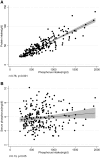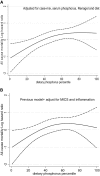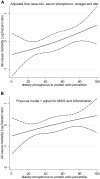Association of dietary phosphorus intake and phosphorus to protein ratio with mortality in hemodialysis patients
- PMID: 20185606
- PMCID: PMC2849686
- DOI: 10.2215/CJN.08601209
Association of dietary phosphorus intake and phosphorus to protein ratio with mortality in hemodialysis patients
Abstract
Background and objectives: Epidemiologic studies show an association between higher predialysis serum phosphorus and increased death risk in maintenance hemodialysis (MHD) patients. The hypothesis that higher dietary phosphorus intake and higher phosphorus content per gram of dietary protein intake are each associated with increased mortality in MHD patients was examined.
Design, setting, participants, & measurements: Food frequency questionnaires were used to conduct a cohort study to examine the survival predictability of dietary phosphorus and the ratio of phosphorus to protein intake. At the start of the cohort, Cox proportional hazard regression was used in 224 MHD patients, who were followed for up to 5 years (2001 to 2006).
Results: Both higher dietary phosphorus intake and a higher dietary phosphorus to protein ratio were associated with significantly increased death hazard ratios (HR) in the unadjusted models and after incremental adjustments for case-mix, diet, serum phosphorus, malnutrition-inflammation complex syndrome, and inflammatory markers. The HR of the highest (compared with lowest) dietary phosphorus intake tertile in the fully adjusted model was 2.37. Across categories of dietary phosphorus to protein ratios of <12, 12 to <14, 14 to <16, and > or =16 mg/g, death HRs were 1.13, 1.00 (reference value), 1.80, and 1.99, respectively. Cubic spline models of the survival analyses showed similar incremental associations.
Conclusions: Higher dietary phosphorus intake and higher dietary phosphorus to protein ratios are each associated with increased death risk in MHD patients, even after adjustments for serum phosphorus, phosphate binders and their types, and dietary protein, energy, and potassium intakes.
Figures



References
-
- Go AS, Chertow GM, Fan D, McCulloch CE, Hsu CY: Chronic kidney disease and the risks of death, cardiovascular events, and hospitalization. N Engl J Med 351: 1296–1305, 2004 - PubMed
-
- Berl T, Henrich W: Kidney-heart interactions: Epidemiology, pathogenesis, and treatment. Clin J Am Soc Nephrol 1: 8–18, 2006 - PubMed
-
- Levin A, Bakris GL, Molitch M, Smulders M, Tian J, Williams LA, Andress DL: Prevalence of abnormal serum vitamin D, PTH, calcium, and phosphorus in patients with chronic kidney disease: Results of the study to evaluate early kidney disease. Kidney Int 71: 31–38, 2007 - PubMed
-
- Brenner BM: Nephron adaptation to renal injury or ablation. Am J Physiol 249: F324–F337, 1985 - PubMed
-
- Kalantar-Zadeh K, Kuwae N, Regidor DL, Kovesdy CP, Kilpatrick RD, Shinaberger CS, McAllister CJ, Budoff MJ, Salusky IB, Kopple JD: Survival predictability of time-varying indicators of bone disease in maintenance hemodialysis patients. Kidney Int 70: 771–780, 2006 - PubMed
Publication types
MeSH terms
Substances
Grants and funding
LinkOut - more resources
Full Text Sources
Other Literature Sources
Medical

